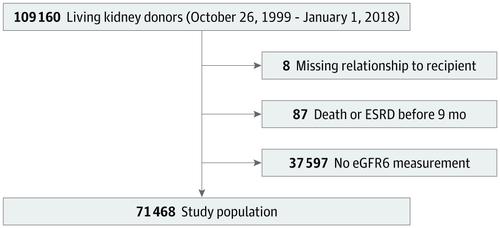当前位置:
X-MOL 学术
›
JAMA Surg.
›
论文详情
Our official English website, www.x-mol.net, welcomes your feedback! (Note: you will need to create a separate account there.)
Association of Early Postdonation Renal Function With Subsequent Risk of End-Stage Renal Disease in Living Kidney Donors.
JAMA Surgery ( IF 16.9 ) Pub Date : 2020-01-22 , DOI: 10.1001/jamasurg.2019.5472 Allan B Massie 1, 2 , Courtenay M Holscher 1 , Macey L Henderson 1 , Lara M Fahmy 1 , Alvin G Thomas 1 , Fawaz Al Ammary 3 , Samantha N Getsin 1 , Jon J Snyder 4 , Krista L Lentine 5 , Amit X Garg 6 , Dorry L Segev 1, 2, 4
JAMA Surgery ( IF 16.9 ) Pub Date : 2020-01-22 , DOI: 10.1001/jamasurg.2019.5472 Allan B Massie 1, 2 , Courtenay M Holscher 1 , Macey L Henderson 1 , Lara M Fahmy 1 , Alvin G Thomas 1 , Fawaz Al Ammary 3 , Samantha N Getsin 1 , Jon J Snyder 4 , Krista L Lentine 5 , Amit X Garg 6 , Dorry L Segev 1, 2, 4
Affiliation

|
Importance
Living kidney donation is associated with increased long-term risk of end-stage renal disease (ESRD). An early postdonation marker of ESRD risk could improve postdonation risk assessment and counseling for kidney donors and allow early intervention for donors at increased risk.
Objective
To determine the association between renal function in the first 6 months postdonation and subsequent risk of ESRD in kidney donors.
Design, Setting, and Participants
This secondary analysis of a prospective national cohort uses a population-based registry of all living kidney donors in the United States between October 26, 1999, and January 1, 2018, with follow-up through December 31, 2018. All kidney donors who had donated in the date range and had serum creatinine measured at 6 months (±3 months) postdonation were included.
Exposures
Renal function as measured by estimated glomerular filtration rate 6 months after donation (eGFR6).
Main Outcomes and Measures
End-stage renal disease, ascertained via linkage to Centers for Medicare & Medicaid Services data.
Results
A total of 71 468 living kidney donors were included (of 109 065 total donors over this period). Their median (interquartile range) eGFR6 was 63 (54-74) mL/min/1.73 m2. Cumulative incidence of ESRD at 15 years postdonation ranged from 11.7 donors per 10 000 donors with eGFR6 values greater than 70 mL/min/1.73 m2 to 33.1 donors per 10 000 donors with eGFR6 values of 50 mL/min/1.73 m2 or less. Adjusting for age, race, sex, body mass index, and biological relationship, every 10 mL/min/1.73 m2 reduction in eGFR6 was associated with a 28% increased risk of ESRD (adjusted hazard ratio, 1.28 [95% CI, 1.06-1.54]; P = .009). The association between predonation eGFR and ESRD was not significant and was fully mediated by eGFR6 (adjusted hazard ratio, 1.00 [95% CI, 0.86-1.17]; P = .97). The postdonation eGFR value was a better marker of ESRD than eGFR decline after donation or the ratio of eGFR6 to predonation eGFR, as determined by the Akaike information criterion (in which a lower value indicates a better model fit; eGFR6, 1495.61; predonation eGFR - eGFR6, 1503.58; eGFR6 / predonation eGFR, 1502.30).
Conclusions and Relevance
In this study, there was an independent association of eGFR6 with subsequent ESRD risk in living kidney donors, even after adjusting for predonation characteristics. The findings support measurement of early postdonation serum creatinine monitoring in living kidney donors, and the use of these data to help identify donors who might need more careful surveillance and early intervention.
中文翻译:

活体肾脏捐献者早期捐献后肾功能与终末期肾脏疾病风险的关联。
重要性活体肾脏捐赠与终末期肾脏疾病(ESRD)的长期风险增加相关。ESRD风险的早期捐赠后标志物可以改善肾脏捐赠者的捐赠后风险评估和咨询,并为处于较高风险中的捐赠者提供早期干预。目的确定供肾者最初六个月的肾功能与随后的ESRD风险之间的关系。设计,背景和参与者这项针对预期国家队列的次要分析使用了1999年10月26日至2018年1月1日期间美国所有活体肾脏供体的基于人口的登记表,并随访至2018年12月31日。 。包括所有在该日期范围内捐赠并在捐赠后6个月(±3个月)测量血清肌酐的肾脏捐赠者。暴露肾功能由捐赠后6个月的估计肾小球滤过率(eGFR6)测得。主要结果和措施通过与Medicare和Medicaid Services中心数据的链接确定了终末期肾脏疾病。结果总共包括71 468个活体肾脏供体(在此期间总共109 065个供体中)。他们的中位数(四分位数范围)eGFR6为63(54-74)mL / min / 1.73 m2。捐赠后15年ESRD的累积发生率范围为eGFR6值大于70 mL / min / 1.73 m2的每10 000个供体中有11.7个供体,eGFR6值小于50 mL / min / 1.73 m2或小于1万的供体中有33.1个供体。调整年龄,种族,性别,体重指数和生物学关系后,eGFR6每降低10 mL / min / 1.73 m2,ESRD风险增加28%(调整后的危险比1.28 [1.2%[95%CI,1.06- 1。54]; P = .009)。捐赠前eGFR与ESRD之间的关联不显着,并且完全由eGFR6介导(风险比调整为1.00 [95%CI,0.86-1.17]; P = 0.97)。捐赠后的eGFR值比捐赠后eGFR下降或eGFR6与捐赠前eGFR的比率更好,是ESRD的标志物(由Akaike信息标准确定(其中较低的值表示较好的模型拟合; eGFR6,1495.61;捐赠前eGFR- eGFR6,1503.58; eGFR6 /捐赠前eGFR,1502.30)。结论与相关性在这项研究中,即使在调整了捐赠前特征后,活肾捐献者中eGFR6与随后的ESRD风险也存在独立关联。这些发现支持对活体肾脏供体中早期捐赠后血清肌酐监测的测量,
更新日期:2020-03-19
中文翻译:

活体肾脏捐献者早期捐献后肾功能与终末期肾脏疾病风险的关联。
重要性活体肾脏捐赠与终末期肾脏疾病(ESRD)的长期风险增加相关。ESRD风险的早期捐赠后标志物可以改善肾脏捐赠者的捐赠后风险评估和咨询,并为处于较高风险中的捐赠者提供早期干预。目的确定供肾者最初六个月的肾功能与随后的ESRD风险之间的关系。设计,背景和参与者这项针对预期国家队列的次要分析使用了1999年10月26日至2018年1月1日期间美国所有活体肾脏供体的基于人口的登记表,并随访至2018年12月31日。 。包括所有在该日期范围内捐赠并在捐赠后6个月(±3个月)测量血清肌酐的肾脏捐赠者。暴露肾功能由捐赠后6个月的估计肾小球滤过率(eGFR6)测得。主要结果和措施通过与Medicare和Medicaid Services中心数据的链接确定了终末期肾脏疾病。结果总共包括71 468个活体肾脏供体(在此期间总共109 065个供体中)。他们的中位数(四分位数范围)eGFR6为63(54-74)mL / min / 1.73 m2。捐赠后15年ESRD的累积发生率范围为eGFR6值大于70 mL / min / 1.73 m2的每10 000个供体中有11.7个供体,eGFR6值小于50 mL / min / 1.73 m2或小于1万的供体中有33.1个供体。调整年龄,种族,性别,体重指数和生物学关系后,eGFR6每降低10 mL / min / 1.73 m2,ESRD风险增加28%(调整后的危险比1.28 [1.2%[95%CI,1.06- 1。54]; P = .009)。捐赠前eGFR与ESRD之间的关联不显着,并且完全由eGFR6介导(风险比调整为1.00 [95%CI,0.86-1.17]; P = 0.97)。捐赠后的eGFR值比捐赠后eGFR下降或eGFR6与捐赠前eGFR的比率更好,是ESRD的标志物(由Akaike信息标准确定(其中较低的值表示较好的模型拟合; eGFR6,1495.61;捐赠前eGFR- eGFR6,1503.58; eGFR6 /捐赠前eGFR,1502.30)。结论与相关性在这项研究中,即使在调整了捐赠前特征后,活肾捐献者中eGFR6与随后的ESRD风险也存在独立关联。这些发现支持对活体肾脏供体中早期捐赠后血清肌酐监测的测量,


























 京公网安备 11010802027423号
京公网安备 11010802027423号